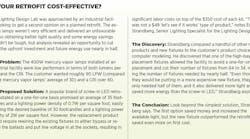Saving money on lighting energy and labor doesn’t always require an expensive project. Sometimes it’s simply a matter of smarter maintenance and selective upgrades.
Which fits your needs and budget best: relamping, retrofits, replacement or a redesign? Weigh the upfront costs and long-term prospects of each to find the best course of action for your facility.
Relamp the Right Way
Though relamping is a simple replacement of one lamp for another of the same type, there’s a significant cost savings to be found with relamping projects. The biggest of these is relamping in large groups, like a whole floor or even the whole building, rather than spot replacements of individual lamps as they burn out or depreciate.
“Replacing one lamp takes time for a worker to get up there, and depending on where the lamp is located, it could also require special equipment,” explains Chris Baird, Vice President of Marketing and Sales for manufacturer HyLite LED, LLC. “In some situations, building owners may have to rent a lift to relamp certain areas, and they especially would want to relamp in large groups so that they only have to rent a lift at that one point in time vs. every time a few lamps fail.”
Group relamping also lets building owners take advantage of economies of scale by ordering more lamps at once and allowing crews to set up for one large project instead of multiple small ones. Replacing lamps before they fail may seem wasteful, but the lamps that still have some life left may come in handy, says Eric Strandberg, Senior Lighting Specialist for the Lighting Design Lab, a utility-funded energy efficiency education resource based in the Northwest.
“When you group relamp, you’re aiming to replace lamps at around 70 to 80% of rated lamp life. Hold back a few of the lamps that have some life still in them so that if any of the new lamps have premature failure, you have a used lamp that you can put in until the 70 to 80% mark rolls around again,” Strandberg recommends. “The lifetime you’ll use varies depending on the technology, the cost and how much risk the owner is willing to take. However, LED changes the equation – your typical maintenance cycle on traditional lamps might be 3 to 5 years, but with LEDs that theoretically last 12 to 15 years, you might be looking at 10-year maintenance cycles. Often in that time, something new has come along or the use of the space changes. You may have to fundamentally reevaluate the lighting system itself.”
Kits: Between Relamping and Retrofits
Snap-in kits and lamps made to fit into fixtures for older lamp types (for example, a CFL made to screw into the socket for an incandescent light bulb) technically qualify as retrofits, according to many utility incentive programs and technology certification bodies, but in practice they seem to occupy the gray area between relamping and a full-scale retrofit.
“In terms of doing a retrofit, you have several options,” Baird explains. “Going with a new fixture is one solution, and if you’re looking for a more cost-effective strategy, there are tons of retrofit lamp options and kits that can fit into existing fixtures. The main benefit of those is a lower initial investment. If you’re looking at getting newer technology like LED lighting in place for cost and energy savings, a lower upfront investment translates into quicker payback and ROI.”
While kits and simple upgrades may feel more like a relamping job, Strandberg recommends treating them like a retrofit by doing the same review of changing loads, optics and other factors that you’d do for a retrofit with a full fixture replacement.
“You’re still going from one type of load to another, and that may have implications on your system, including controls. You may have dimming on an incandescent, for example, and now that you’ve put in an LED you may have to put in a different dimmer,” Strandberg says. “If everything works the way it’s supposed to, you shouldn’t have to change any of those systems, but you still need to look at them and make sure it is going to work.”
When Relamping Isn’t Enough
If the projected savings on group relamping or even a simple one-for-one replacement with a retrofit kit aren’t good enough, it may be time to invest in a more comprehensive retrofit or even a lighting redesign. Your building may be a good candidate for an upgrade if it needs better light quality or distribution or if your current lighting system just isn’t meeting your budgetary goals.
“The decision to relamp vs. performing a complete lighting retrofit depends on your energy and performance goals for the space, how the fixtures are currently controlled, time constraints and budget,” says Matt Ochs, Director of Product Management for manufacturer Lutron Electronics. “If you are looking to deliver high-performance lighting capability with reduced energy use and more flexible control, a lighting retrofit presents the perfect opportunity to install a flexible, digital lighting control solution. In the scope of a complete lighting retrofit, the addition of a control solution represents a relatively small percentage of cost while adding value and significantly improving the comfort of the space with dimming and other control strategies.”
PageBreakLED lighting continues to drop in cost and improve in quality, and it now boasts the lowest total cost of ownership of any lighting technology, Baird adds. Compare your current lighting system with prospective upgrade technologies by examining your costs and savings over a period of five years or more.
“What will it cost me to operate over the next five years in terms of energy? What’s the lifetime of each technology and how often will I have to replace them? What’s the warranty on the upgrade option? Can the manufacturer stand behind the product?” Baird says. “At this point, I think if you’re not using LED, it’s a good time to look at your options there. The energy savings up front and the long-term maintenance costs translate into a larger savings over time.”
How to Make the Best Choice
Whether you’re changing your relamping strategy or opting for a replacement or redesign, it’s crucial that you do your homework beforehand so you don’t run into problems later. Determine how much energy or maintenance you should save beforehand so you can watch for higher-than-expected spending that can indicate trouble, and know the ins and outs of any new technology so the installation goes smoothly. Get it right the first time with these tips.
1) Evaluate the condition of old fixtures. Opting for long-life lamps may make sense from a savings standpoint, but if the existing fixtures are worn out and will need to be replaced sooner than the lamps, you may find you’ve wasted your money when you should have just replaced the whole thing at once.
“If the existing fixture is 25 years old and has aging sockets that need to be replaced anyway, you don’t want to put a 10-year lamp in there because the socket could fail in 5 years,” Strandberg says. “Look at the condition of your existing fixtures. If there’s something special about them, like decorative fixtures in the lobby that have a historic look, you’ll have to put some work into refurbishing that fixture. It doesn’t make sense to put a long-life, high-cost lamp into aging infrastructure.”
In cases like that, it makes the most sense to do at least a floor at once so that you’re not faced with mismatched fixtures in the same general area, Strandberg adds. “Even if a few fixtures are still in good shape, they might not look the same. That’s irrelevant in applications like warehousing, but if you have a grocery store, office space or school, you probably want them all to match.”
2) Assess the performance of the current lighting system and incorporate your findings into the search for new products. Strandberg recommends looking around your building to see how the current system is performing in terms of light distribution, quality and quantity. Are some areas overlit? Is the light color too warm or cool? Has the use of the space changed since the current system was installed?
“If everything is great, then you want to try and match it as much as possible, but often there are ways to improve things,” says Strandberg. “It’s not always about maximum energy savings. Sometimes it’s about having a chance to say, ‘We need more light than we currently have.’ Evaluate the existing lighting to see how it’s performing instead of saying, ‘It’s a three-lamp fixture, so let’s put in three of the new lamps.’ You don’t always need to do that.”
3) Look at all components when you use a kit. Tube-style LEDs that replace linear fluorescent lighting sometimes leave the original ballast intact, which can throw off your relamping schedule later, Baird explains. “There are alternative options that allow you to eliminate the ballast, which means you have less maintenance down the road,” Baird adds. “The ballast can expire earlier than the lamp if you’re looking at upgrading the lamps separately. You might want to consider replacing the ballast at the same time or going with a solution that doesn’t require a ballast at all to save on long-term maintenance costs.”
4) Check compatibility. If you’re not replacing every component, consult with the manufacturer to make sure that the new installation is compatible with the old fixture, location and ballast (if applicable). “If you’re upgrading linear lighting and keeping the old ballast, make sure it’s on the manufacturer’s recommended list of compatible ballasts. Otherwise it could be an issue for the life of the lamp,” Baird suggests. “Also check the fixture and ask the manufacturer whether it’s OK for that particular installation. For example, if it’s an enclosed fixture and you’re putting LEDs into it, do you need more space for heat dissipation?”
5) Field-test samples before committing to an order. Consider it a red flag if the manufacturer you’re considering won’t let you try out lighting products in your facility before you buy enough for an upgrade, Strandberg warns. There’s no replacement for a field test. In addition to seeing how the new lighting products look in your facility, you can test other lighting measures alongside them – for example, painting walls with more reflective surfaces to get more mileage out of the same amount of light.
“Repainting to a lighter color or even just going from a tan to a white can increased both perceived and measured brightness dramatically,” Strandberg says. “Examine surface reflectance and see if you can make changes there while you’re upgrading.”
Janelle Penny [email protected] is Senior Editor of BUILDINGS.



